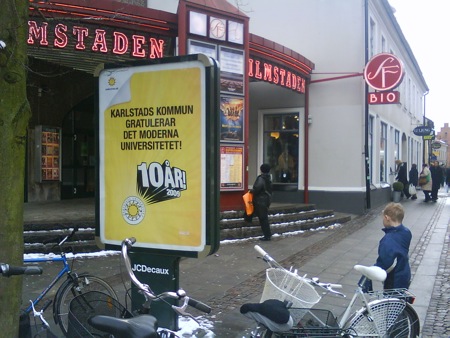En eventuellt pandemi av svininfluensa skulle kunna få stora följder även om det skulle visa sig att själva sjukdomsförloppet på individnivå inte var värre än standardinfluensan (den där som temporärt reducerade mig till ett kvidande gnälligt vrak i vintras). En normal influensa men med ett större antal människor smittade samtidigt skulle utsätta sjukvården och kanske andra vitala samhällsfunktioner för kraftig belastning.
Den här mÃ¥hända triviala observationen – en stÃ¥ndpunkt nÃ¥gonstans mellan den Ã¥ngestskapande domedagsalarmismen och den sorglösa detlösersigalltidoptimismen – är utgÃ¥ngspunkten för den kritik som medicinbloggen Effect Measure riktar mot den amerikanska sjukvÃ¥rden:
A bad flu season can fill hospital emergency rooms and in patient beds to the bursting point. We currently have fewer staffed hospital beds per capita than we did in the last pandemic, 1968 (the ”Hong Kong flu”). There is no reserve capacity. We can’t just add physical beds. Beds don’t take care of patients. Nurses and doctors do.
Now take a bad flu season and double it. To each individual it’s the same disease but now everybody is getting it at once, in every community and all over the world. In terms of virulence, it’s a mild pandemic. It’s not a lethal virus like 1918. But in terms of social disruption it could be very bad. If twice as many people get sick, the number of deaths could be 80,000 in the US instead of 40,000. Gurneys would line the hallways of hospitals and clinics. And absenteeism amongst health care workers would compound the problem. Infrastructure would probably survive intact. No need to have your own water supply or electricity generator. But it would be a very rough ride.
Visst, jag kan höra motargumenten – ”de här läkarna talar i egen sak” (skribenterna bakom Effect Measure presenterar sig som ”senior public health scientists and practitioners” (de är anonyma, vilket jag egentligen inte tycker hör hemma i forskarbloggosfären)) och de ser, menar säkert nÃ¥gon cyniker därute, kanske här en möjlighet att ro hem nÃ¥gra Obamaska krispaketsmiljarder till den egna sektorn – men jag finner det ändÃ¥ intressant.
Pandemi blir politik. Hur mycket resurser ska ett samhälle satsa på sjukvården, hur mycket överkapacitet skall man ha vilande i systemet?
We are not fully prepared for the demands a lot of sickness in our communities would place on a very weakened medical and public health system. One reason for the lack of preparation is that too few people cared enough
fortsätter Effect Measure och några kommentatorer fyller i:
As an ER physician at a teaching hospital, I am constantly frustrated by the lack of attention the govt has given in regard to the fact that most EDs in the USA function above capacity and we have little to NO surge capacity. A white House report in March 2008 called 31 EDs throughout the USA at the same time during a Monday afternoon and asked how many people they could take (simulated a mass casualty event that had same number of victims as the Madrid train bombings several years back–i.e. 215 victims) and most could either take 1 or 2 or none. Yes I wrote those numbers correct. One hospital in Wash DC was functioning at 250% over capacity during that nice phone chat! We have neglected our public health infrastructure
skriver medicinaren Mark Gendreau.
Frankly, I like the idea that we’re forced to think about what we really demand from our governments (public health management e.g.) and not cultivation of fear over terrorism or socialism.
I am disturbed that there’s little profitability anymore in fighting disease, but instead all the ’value add’ is in lifestyle enhancement. Isn’t it true that children’s vaccines are less available because of the low profit margins?
undrar en annan skribent i kommentarsflödet på Effect Measure.
Tara Smith är inne på liknande saker.
Den ovanstÃ¥ende diskussionen gäller USA. Det är definitivt mycket värre pÃ¥ vissa hÃ¥ll i världen, kanske bättre än i USA pÃ¥ andra. Vi har hos oss en fantastisk sjukvÃ¥rd – det jag sett av svensk sjukvÃ¥rd pÃ¥ nära hÃ¥ll gör mig stum av beundran – men man undrar om vÃ¥rt sjukvÃ¥rdssystem nÃ¥gonsin, i modern tid, utsatts för en substantiell spik i patientinflödet? Vilka möjligheter finns det att snabbt omgruppera resurser inom systemet? Vad finns det för framtidsscenarion kopplade till tillfälliga överbelastningar pÃ¥ sjukvÃ¥rden; nÃ¥gonstans borde det finnas nÃ¥gon som simulerar sjukvÃ¥rdssystemet, en SimSjukvÃ¥rd som beslutsunderlag. Det sitter säkert nÃ¥gon pÃ¥ MSB och räknar pÃ¥ det här.
Och visst kommer det att göras politik av det här även i Sverige. Någonstans ser jag ett socialdemokratiskt politiskt utspel under uppsegling. Satsningar på sjukvård och fokhälsa känns (s)-igt. Hur ska den moderatledda regeringen klara det?




